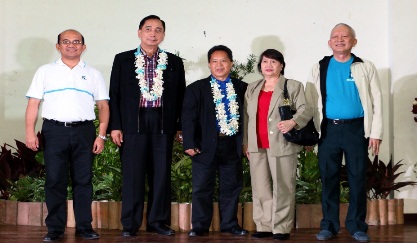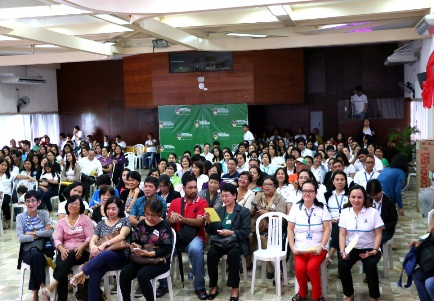 Five of the Department of Science and Technology-Philippine Council for Agriculture, Aquatic and Natural Resources Research and Development's (DOST-PCAARRD) prominent infrastructures were named after research and development (R&D) icons in simple rites held during its Loyalty and Recognition Day.
Five of the Department of Science and Technology-Philippine Council for Agriculture, Aquatic and Natural Resources Research and Development's (DOST-PCAARRD) prominent infrastructures were named after research and development (R&D) icons in simple rites held during its Loyalty and Recognition Day.
Held on December 18, 2015 at DOST-PCAARRD's Elvira Tan Hall, the activity was one of the numerous initiatives led by Dr. Reynaldo V. Ebora in his first nine months of engagement as Acting Executive Director, which officially began on February 16, 2015.
The activity recognized the efforts of the Council's former employees and stewards in charting the affairs of DOST-PCAARRD towards bringing it to its current stature as the state's premiere research and development council for agriculture, aquatic and natural resources concerns.
"We would have not known the PCAARRD of today had it not been for the hard work and dedication of our predecessors; it is just fitting and proper that we recognize them," Ebora said.
Recognized in the activity were Dr. William D. Dar, Executive Director, Philippine Council for Agriculture, Forestry and Natural Resources Research and Development (PCARRD, 1994-1998); Dr. Beatriz P. del Rosario, Officer-in-Charge (1998-1999) and Deputy Executive Director for Research and Development (1989-1998 PCARRD); Dr. Patricio S. Faylon, Executive Director (PCARRD, 1998-2012 and Philippine Council for Agriculture, Aquatic and Natural Resources Research and Development (PCAARRD, 2012-2015).
Also recognized were Dr. Rafael D. Guerrero III, Executive Director, Philippine Council for Aquatic and Marine Research and Development (PCAMRD, 1989-2012); and Dir. Cesario R. Pagdilao, former Deputy Executive Director for Research and Development and a PCAARRD pioneer and stalwart.
Named after Dr. William D. Dar was the second floor of the Bulwagan Panday Karunungan (BPK) in recognition of his enabling the National Agriculture Research System (NARS) to focus on national development goals, for his contribution in expanding the National Agriculture Resources Research and Development Network (NARRDN).
The most fitting attribute for the naming of the hall was Dar's effort in having established BPK as a venue for scientific and technological advancement.
The NARS is a formidable conglomeration of national and regional centers and specialized agencies for agriculture and a network of state colleges and universities, research institutes, and private research agencies engaged in agricultural R&D.
 Created in 1975, the NARRDN (now NAARRDN, to accommodate aquatic concerns), strengthens PCAARRD's national effort in making agriculture, aquatic, and natural resources R&D more responsive to the needs of end-users.
Created in 1975, the NARRDN (now NAARRDN, to accommodate aquatic concerns), strengthens PCAARRD's national effort in making agriculture, aquatic, and natural resources R&D more responsive to the needs of end-users.
The NAARRDN is composed of research centers, state universities and colleges, and government and private agencies that develop and verify appropriate technologies that address specific needs and problem areas.
Dr. Beatriz P. del Rosario was recognized for being the first woman to lead the NARS and for her contribution in capacitating the system and PCARRD, including the PCARRD Regional Consortia.
Among other contributions, del Rosario led the implementation of the integrated R&D program for flagship commodities; set up a seed fund and a one-stop information shop for technologies; and initiated the granting of the “Ugnay Award” to the outstanding consortium. In honor of these contributions, the road from PCAARRD going down the Bureau of Plant Industry was named as Del Rosario Lane.
The Exhibit area located on the ground floor of the PCAARRD Innovation Technology Center (PITC) was named after Dr. Patricio S. Faylon, for his contribution in strengthening PCAARRD’s Technology Transfer Program through the Farmers’ Information and Technology Services (FITS) and the S&T Based Farms (STBFs), as well as for his initiative in establishing the PITC for the promotion of agri-aqua R&D.
The second floor of the same building was dedicated to honor the contribution of the man who is considered as the Father of Tilapia, Dr. Rafael D. Guerrero III. Guerrero was recognized for his contribution to aquaculture R&D in the Philippines. He popularized the technology on sex reversal of Tilapia for increased production and spearheaded the establishment of the National Aquatic Resources Research and Development System (NARRDS), among other R&D contributions.
Considered as the only posthumous recognition was the naming of the road connecting PCAARRD and the PITC. Now known as the Pagdilao Lane, the road pays tribute to Dir. Cesario R. Pagdilao's contribution to aquatic R&D as the country's prime mover of the following big ticket programs in the aquatic and marine R&D sector: Filipinovation on Coral Reef Restoration, the Resilient Seas, Harmful Algal Bloom, the Seaweeds R&D Program, the United Nations Development Programme-GAINEX, and Pharma Seas.
Dir. Pagdilao's passion for marine biology and fisheries management led the Council to continuously develop R&D programs on aquatic sciences for the development of the fisheries industry, protection of marine resources, and upliftment of the socio-economic condition of small fisherfolk.
